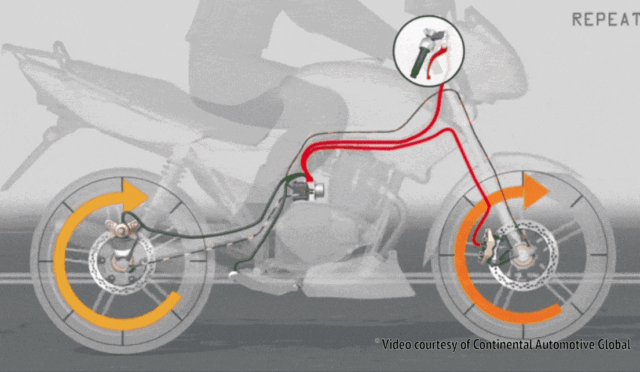Anti-lock Braking System (ABS) plays a crucial role in cycling safety. This technology prevents wheel lock-up during braking. It allows the rider to maintain steering control. This feature is particularly beneficial in slippery conditions. It reduces the risk of skidding and falling.
ABS works by modulating brake pressure. When a wheel begins to lock, the system releases and reapplies brake force quickly. This process happens many times per second. As a result, the rider can stop more safely and effectively. ABS is widely used in motorcycles and vehicles. Its implementation in cycling is becoming more common.
While traditional braking systems can be effective, they lack the advanced features of ABS. Cyclists may face challenges, especially in emergency stops. The ABS system helps in these situations by enhancing stability. Studies show that ABS-equipped bikes can reduce stopping distances in critical situations.
When considering a bike with ABS, check the specifications. Many modern motorcycles have this feature as standard. Prices can vary widely. On average, a motorcycle with ABS can cost an additional $500 to $1,500 compared to non-ABS models. Nevertheless, the investment may lead to better safety and confidence on the road.
In addition to safety, ABS may affect insurance costs. Some insurance companies offer discounts for bikes equipped with ABS. This benefit can make owning an ABS-equipped bike more affordable over time.
Overall, ABS is an important consideration for cycling. It provides enhanced control and safety. As technology advances, more cyclists are recognizing its value. For those who ride in varied conditions, ABS is a worthy investment.
Understanding The Role Of ABS In Enhancing Motorcycle Safety And Control
Motorcycle safety is a priority for every rider. One key feature that enhances safety is Anti-lock Braking System (ABS). Understanding how ABS works can significantly improve your riding experience.
ABS is designed to prevent wheel lock-up during hard braking. This technology allows the rider to maintain steering control, even in emergency situations. When a rider applies the brakes suddenly, ABS modulates brake pressure. This prevents the wheels from locking, helping the rider to steer away from obstacles.
Key benefits of ABS include:
- Improved stability during braking.
- Reduced risk of skidding.
- Higher chance of avoiding accidents.
ABS is especially important on wet or slippery roads. According to studies, motorcycles equipped with ABS are involved in fewer accidents than those without. The difference can be significant. Riders with ABS have a better chance of staying upright and avoiding dangerous situations.
When considering ABS, it is also helpful to know its features. Some notable features include:
| Feature | Description |
|---|---|
| Wheel Speed Sensors | Monitor the speed of each wheel to detect potential lock-up. |
| Hydraulic Modulator | Adjusts brake pressure to prevent wheel lock. |
| Control Unit | Processes data from sensors and activates the modulator. |
In terms of cost, motorcycles with ABS may be slightly more expensive than those without. However, the added safety features can justify the price for many riders. ABS can range from $300 to $1,000 more, depending on the motorcycle model and brand.
Ultimately, understanding the role of ABS is crucial for every motorcyclist. It not only enhances safety but also boosts confidence while riding. Riders who prioritize safety will find ABS to be a beneficial investment in their motorcycle experience.
How Anti-lock Braking Systems (ABS) Improve Performance In Various Riding Conditions
Anti-lock Braking Systems (ABS) play a crucial role in enhancing performance across different riding conditions. These systems prevent wheel lock-up during hard braking, allowing for better control and stability. For cyclists, this technology can significantly improve safety and comfort, especially in challenging environments.
ABS works by modulating brake pressure. This means it adjusts the force applied to the wheels to prevent them from locking. When a rider applies the brakes too hard, ABS detects the potential for a skid. It quickly releases and reapplies the brakes to maintain traction. This process occurs in fractions of a second, ensuring the rider maintains steering control even in emergency situations.
In various riding conditions, ABS offers distinct advantages:
- Wet Conditions: Rain or wet roads can reduce traction. ABS helps maintain grip by preventing wheel lock-up, allowing riders to brake efficiently without losing control.
- Loose Surfaces: On gravel or dirt, brakes can easily lock up. ABS adapts to these surfaces, providing a smoother braking experience and preventing falls.
- Downhill Riding: When descending steep slopes, the risk of skidding increases. ABS enables controlled braking, enhancing rider confidence.
- Emergency Braking: In critical situations, riders often react instinctively. ABS aids in managing sudden stops, reducing the risk of accidents.
The features of ABS systems vary, but generally include:
| Feature | Description |
|---|---|
| Wheel Speed Sensors | Monitor the speed of each wheel to detect lock-up. |
| Hydraulic Control Unit | Modifies brake pressure to prevent skidding. |
| Control Module | Processes data and activates the hydraulic system as needed. |
The price of bikes or vehicles equipped with ABS systems may be slightly higher than those without. However, the added safety and performance benefits often justify the investment. Riders can expect a range of costs based on the type of vehicle and the sophistication of the ABS technology used.
In conclusion, Anti-lock Braking Systems significantly improve performance in various riding conditions. By enhancing control and stability, these systems play a vital role in promoting safer riding experiences. As cycling evolves, embracing technology like ABS is essential for riders seeking better performance and safety on the road.
Exploring The Benefits Of ABS: A Must-Have Feature For Every Serious Cyclist
When it comes to cycling, safety is a top priority. One feature that has gained traction in recent years is Anti-lock Braking System (ABS). This technology is not just for cars; it has made its way into the cycling world. Understanding the benefits of ABS can help serious cyclists make informed decisions.
ABS is designed to prevent wheel lockup during hard braking. This feature is crucial for maintaining control when stopping quickly. Without ABS, a cyclist may skid, leading to loss of balance and potential accidents. With ABS, cyclists can brake harder without fear of losing control.
Here are some key benefits of ABS for cyclists:
- Improved Control: ABS helps maintain traction, especially on wet or slippery surfaces.
- Reduced Stopping Distance: Cyclists can stop faster and more safely with ABS.
- Increased Confidence: Knowing that ABS is there can give riders more freedom to ride aggressively.
- Enhanced Safety: The risk of accidents due to skidding is significantly lower with ABS.
In addition to safety, ABS can also improve performance. Cyclists can ride on varied terrains with more assurance, knowing that the braking system will work effectively. This allows riders to focus on enjoying their journey rather than worrying about potential falls.
When looking at costs, bikes equipped with ABS do tend to be pricier. The price can vary depending on the brand and model. Here’s a simple table showcasing some estimated price ranges:
| Bike Model | Price Range |
|---|---|
| Model A | $1,200 – $1,500 |
| Model B | $2,000 – $2,500 |
| Model C | $3,000 – $3,500 |
It’s clear that ABS is a feature worth considering for serious cyclists. The advantages it offers in terms of safety, control, and confidence make it an essential addition to any bike. As cycling continues to grow in popularity, understanding the importance of ABS can pave the way for safer rides and enjoyable experiences on the road.
Yes, ABS, or Anti-lock Braking System, is crucial for enhancing safety while cycling. It prevents the wheels from locking up during hard braking, allowing for better control and stability.
ABS improves safety by maintaining traction between the tires and the ground, reducing the risk of skidding or losing control when braking suddenly.
Absolutely, ABS is particularly beneficial in wet or slippery conditions as it helps to modulate braking force, leading to increased grip and reduced stopping distances.
No, ABS is not standard on all bicycles; it is more commonly found on certain high-end models or electric bikes designed with advanced safety features.
Unlike traditional braking systems that can cause wheel lockup, ABS automatically adjusts brake pressure to prevent skidding, providing a smoother and safer stopping experience.
Using ABS can enhance your performance by allowing you to brake more effectively, especially in emergency situations, thus improving overall riding confidence and stability.
Investing in a bike with ABS can be worthwhile, particularly for those who ride frequently in varying weather conditions or urban environments where sudden stops may be required.
While ABS generally offers numerous benefits, some cyclists may find it adds weight or complexity to the braking system, and it may not provide a ‘feel’ similar to traditional brakes.
Upgrading a standard bike to include ABS can be technically challenging and may not be feasible; it’s often more effective to purchase a bike that comes equipped with this technology.
Maintaining ABS involves regular checks of the brake components, ensuring that the sensors and hydraulic systems are clean and functioning properly, which may require professional servicing.








